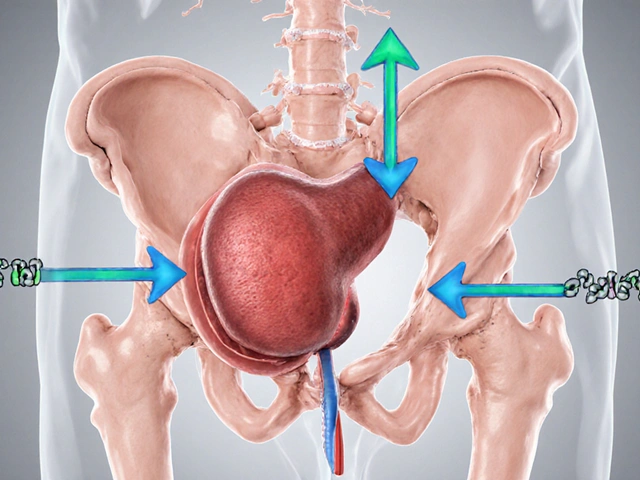
Discoid vs Systemic Lupus Symptom Checker
This tool helps distinguish between discoid lupus (skin-only) and systemic lupus (affecting multiple organs) by identifying key symptoms. Remember, this is for educational purposes only and not a substitute for professional medical advice.
🔹Discoid Lupus Symptoms
- Round, scaly skin patches
- Scarring upon healing
- Common on face, ears, scalp
- Photosensitivity
- Loss of skin pigmentation
🔴Systemic Lupus Symptoms
- Joint pain and swelling
- Fatigue and fever
- Kidney problems
- Butterfly rash on face
- Neurological issues
Check Your Symptoms
Select symptoms you're experiencing:
Analysis Result
Comparison Table
| Feature | Discoid Lupus Erythematosus | Systemic Lupus Erythematosus |
|---|---|---|
| Primary organ involvement | Skin only | Skin, joints, kidneys, brain, blood cells |
| Typical lesions | Round, scaly, often on face or scalp | Butterfly rash, discoid patches, oral ulcers |
| ANA positivity | 40–60% (often low titer) | >95% (high titer) |
| Risk of organ damage | Low (mainly scarring) | High (kidney, CNS, cardiovascular) |
| Treatment focus | Topical steroids, antimalarials | Systemic immunosuppression, organ-specific therapy |
Ever noticed a red, scaly patch on your skin and wondered if it could be more than a simple irritation? That patch could be a sign of discoid lupus erythematosus, a chronic form of lupus that stays mostly on the skin. While many think of lupus as a single disease, it actually comes in several flavors, and each can link to a wider web of autoimmune conditions. This article unpacks how discoid lupus connects to systemic lupus erythematosus and other autoimmune diseases, what symptoms to watch for, and which treatments help keep the immune system in check.
What Is Discoid Lupus Erythematosus?
Discoid lupus erythematosus is a chronic, skin‑limited form of lupus that produces round, red patches-often with a scaly edge and loss of pigment as they heal. The lesions most commonly appear on the face, ears, scalp, and neck, but they can show up anywhere the skin meets sunlight.
Key facts about DLE:
- Occurs in about 10-20% of people with lupus.
- More frequent in women, especially between ages 20 and 40.
- Lesions can cause permanent scarring if left untreated.
Systemic Lupus Erythematosus: The Whole‑Body Counterpart
Systemic lupus erythematosus (SLE) is the classic, multi‑organ version of lupus. In SLE, the immune system attacks not only the skin but also joints, kidneys, the brain, and blood cells, leading to a wide range of symptoms-from joint pain and fatigue to kidney failure.
While DLE stays on the surface, about 15% of people with discoid lesions eventually develop SLE. The two conditions share many of the same immune markers, which is why doctors keep a close eye on skin‑only patients for signs of systemic spread.
Shared Immune Triggers: Antinuclear Antibodies and More
Both discoid and systemic lupus often test positive for antinuclear antibodies (ANA). ANA are proteins that mistakenly target the body’s own cell nuclei, flagging them for attack. A positive ANA test doesn’t guarantee lupus, but it raises the index of suspicion, especially when paired with characteristic symptoms.
Other autoantibodies that link the two forms include anti‑dsDNA, anti‑Smith, and antiphospholipid antibodies. The presence of these markers can predict a higher risk that skin‑only disease will evolve into systemic involvement.

How Discoid Lupus Connects to Other Autoimmune Diseases
Autoimmune diseases rarely exist in isolation. If you have one, the odds of developing another rise sharply-a phenomenon called polyautoimmunity. Here are a few conditions that commonly appear alongside discoid lupus:
- Rheumatoid arthritis: Joint pain and swelling can emerge even when skin lesions dominate the picture.
- Hashimoto’s thyroiditis: An under‑active thyroid often shares genetic risk factors with lupus.
- Sjogren’s syndrome: Dry eyes and mouth may be reported by patients with cutaneous lupus.
- Psoriasis: Overlapping skin inflammation pathways sometimes lead to dual diagnoses.
Understanding these links helps clinicians screen for hidden problems early, reducing long‑term complications.
Symptoms That Hint at Systemic Spread
If you’ve been diagnosed with discoid lupus, keep an eye out for these warning signs that could indicate systemic involvement:
- New joint pain or swelling that isn’t explained by injury.
- Unexplained fever, fatigue, or weight loss.
- Kidney‑related symptoms: swelling in the ankles, foamy urine, or blood in the urine.
- Neurological changes: headaches, confusion, or seizures.
- Photosensitivity that worsens beyond the skin, causing rashes on other body parts after sun exposure.
Spotting these early can prompt a blood work panel (including ANA, anti‑dsDNA, complement levels) and a timely referral to a rheumatologist.
Diagnostic Toolbox: From Skin Biopsy to Blood Tests
A definitive diagnosis of discoid lupus usually starts with a skin biopsy. A tiny sample of the lesion is examined under a microscope for the classic “interface dermatitis” pattern and deposits of immune complexes along the skin’s basement membrane.
Blood work complements the biopsy. Doctors look for:
- Positive ANA (sensitivity≈95% for lupus overall).
- Specific antibodies (anti‑dsDNA, anti‑Smith) that point toward systemic disease.
- Complement levels (C3, C4) - low levels often signal active SLE.
Combining clinical exam, biopsy, and labs gives a clear picture of where the disease sits on the lupus spectrum.

Treatment Options: Keeping the Immune System in Check
Management strategies aim to calm the immune attack, protect the skin, and prevent progression to systemic disease. The mainstays include:
- Hydroxychloroquine - an antimalarial drug that reduces skin lesions in 70‑80% of patients and also lowers the risk of SLE flare‑ups.
- Topical corticosteroids - applied directly to lesions to shrink inflammation quickly.
- Calcineurin inhibitors (tacrolimus or pimecrolimus) - steroid‑sparing options for sensitive areas like the face.
- Systemic immunosuppressants (methotrexate, mycophenolate) - reserved for refractory cases or when systemic involvement is confirmed.
- Sun protection - broad‑spectrum SPF30+ sunscreen, protective clothing, and avoiding peak sun hours are essential because UV light can reignite lesions.
Regular follow‑up visits allow dosage tweaks based on disease activity and side‑effect monitoring, such as retinal exams for hydroxychloroquine.
Living With Discoid Lupus: Practical Tips
Beyond medication, lifestyle tweaks make a big difference. Here are some everyday actions that help keep the skin calm:
- Apply sunscreen every morning, even on cloudy days.
- Use gentle, fragrance‑free cleansers; harsh soaps can aggravate lesions.
- Stay hydrated - well‑watered skin repairs itself faster.
- Limit alcohol and smoking; both worsen autoimmune inflammation.
- Track flare‑ups in a diary to identify triggers (e.g., stress, certain foods).
Connecting with a support group-online or in‑person-can also provide emotional relief and practical advice.
Comparison: Discoid Lupus vs Systemic Lupus
| Feature | Discoid Lupus Erythematosus | Systemic Lupus Erythematosus |
|---|---|---|
| Primary organ involvement | Skin only | Skin, joints, kidneys, brain, blood cells |
| Typical lesions | Round, scaly, often on face or scalp | Butterfly rash, discoid patches, oral ulcers |
| ANA positivity | 40‑60% (often low titer) | >95% (high titer) |
| Risk of organ damage | Low (mainly scarring) | High (kidney, CNS, cardiovascular) |
| Treatment focus | Topical steroids, antimalarials | Systemic immunosuppression, organ‑specific therapy |
Frequently Asked Questions
Can discoid lupus become systemic lupus?
Yes. About 15‑20% of people with discoid lupus develop systemic lupus erythematosus over time, especially if they have positive ANA or other autoantibodies.
Is a skin biopsy always required?
A biopsy is the gold standard for confirming discoid lupus, but in clear‑cut cases doctors may rely on clinical appearance and lab tests, especially if the lesion is classic and the patient has other lupus signs.
What lifestyle changes help control flares?
Sun protection, gentle skin care, quitting smoking, limiting alcohol, staying hydrated, and stress management are all proven to reduce flare frequency.
Are there any dietary recommendations?
No single diet cures lupus, but a Mediterranean‑style diet rich in omega‑3 fatty acids, fruits, and vegetables may lower overall inflammation.
How often should I see a rheumatologist?
If you only have skin lesions, a dermatologist can manage you, but a rheumatology check‑up every 6‑12months is advisable to watch for systemic signs.
Bottom line: recognizing the link between discoid lesions and the broader lupus spectrum empowers patients to act early, protect their skin, and keep other autoimmune conditions at bay. If you suspect a rash isn’t just a rash, reach out to a healthcare professional-you could be preventing a bigger problem down the line.





Joe Murrey
October 7, 2025 AT 15:43interesting read, i learned the diff between discoid and systemic lupus today.
Tracy Harris
October 7, 2025 AT 19:36While the article provides a comprehensive overview, it overlooks the nuanced immunopathology that distinguishes cutaneous from systemic manifestations. The author could have expanded on the role of complement consumption in organ involvement. Moreover, the discussion of therapeutic side‑effects is rather superficial. A more rigorous citation of recent clinical trials would lend greater authority to the piece.
Sorcha Knight
October 7, 2025 AT 23:46Wow, this is sooo helpful!! 😍 The way it breaks down the skin‑only vs. whole‑body lupus really hits home. 🤔 I always thought lupus was just one thing, but now I see it’s a whole spectrum. Thanks for the clear tables and the sunscreen tips – lifesaver!
Jackie Felipe
October 8, 2025 AT 03:56I think the article is good but it could use a bit more on diet. Maybe add some simple tips for people who want to lower inflammation. Also a reminder that regular check‑ups help catch organ issues early.
debashis chakravarty
October 8, 2025 AT 08:06The piece accurately outlines the serological overlap between DLE and SLE, yet it fails to address the statistical likelihood of progression in different ethnic groups. One must consider that ANA positivity alone is insufficient without context. Furthermore, the therapeutic hierarchy presented omits the latest evidence regarding belimumab in cutaneous disease. A more critical appraisal would benefit clinicians seeking guidance.
Daniel Brake
October 8, 2025 AT 12:16Reading this, I am reminded of the philosophical notion that the body often mirrors the mind’s hidden turmoil. When skin lesions appear, perhaps it is an invitation to reflect on internal imbalances before they manifest systemically.
Emily Stangel
October 8, 2025 AT 16:26Thank you for such an exhaustive resource; it truly serves as a bridge between patient curiosity and clinical nuance. The systematic breakdown of symptoms allows readers to map their own experiences onto the broader lupus spectrum, which can be both reassuring and motivating. By emphasizing the importance of early detection, the article underscores how timely intervention may impede progression from cutaneous to systemic disease, a point often underappreciated in lay literature. The inclusion of both laboratory markers-such as ANA titers and complement levels-and their relative predictive values provides a clear diagnostic roadmap. Moreover, the practical lifestyle recommendations, ranging from diligent photoprotection to hydration and stress management, empower patients to take ownership of their health beyond pharmacologic measures. I particularly appreciate the balanced discussion of topical versus systemic therapies, highlighting how hydroxychloroquine serves dual purposes: attenuating skin lesions while reducing systemic flare risk. The detailed table comparing treatment modalities offers a quick reference that clinicians and patients alike can consult. Additionally, the article’s acknowledgment of polyautoimmunity reminds us that lupus rarely exists in isolation, prompting vigilance for co‑morbid conditions such as rheumatoid arthritis or thyroiditis. The emphasis on regular rheumatology follow‑ups, even for those with seemingly skin‑limited disease, reflects a proactive stance that could translate into better long‑term outcomes. While the article is comprehensive, it might benefit from a brief section on emerging biologic agents currently under investigation for refractory cutaneous lupus. In sum, this piece not only educates but also fosters a collaborative patient‑provider dynamic, encouraging informed discussions during appointments.
Finally, the supportive tone throughout the guide reassures readers that with proper care, many can lead active, fulfilling lives despite the challenges of lupus.
Suzi Dronzek
October 8, 2025 AT 20:36Although the article is thorough, it unfortunately glosses over the psychosocial burden that patients endure. The emotional toll of chronic skin lesions cannot be understated, and the discussion should have incorporated mental health strategies. Moreover, the recommendation to use topical steroids fails to mention the risk of atrophy with prolonged use. A more balanced approach would include non‑steroidal alternatives and patient education on proper application techniques.
Aakash Jadhav
October 9, 2025 AT 00:46Nice summary, super helpful.
Amanda Seech
October 9, 2025 AT 04:56Great info! I liked the simple tips like wear sunscreen all day. My friend had discoid and the guide helped her see when to see a doc.
Lisa Collie
October 9, 2025 AT 09:06While the article is informative, it adopts a tone that borders on oversimplification. One must recognize that lupus pathogenesis is a labyrinth of immunological pathways, not merely a checklist of symptoms. Therefore, the piece would benefit from a deeper dive into cellular mechanisms rather than relying on superficial tables.
Avinash Sinha
October 9, 2025 AT 13:16Wow, this guide paints lupus in vivid colors – from the bright butterfly rash to the shadowy depths of organ involvement. It’s like a literary canvas where each symptom adds a brushstroke to the masterpiece of understanding.
ADAMA ZAMPOU
October 9, 2025 AT 17:26In light of the comprehensive review presented, one may contemplate the epistemological implications of categorizing autoimmune entities. Does the dichotomy between discoid and systemic lupus reflect an ontological reality, or is it a heuristic construct for clinical convenience? Such philosophical inquiry may guide future research directions.
Liam McDonald
October 9, 2025 AT 21:36I appreciate the thoroughness of this guide it really helps patients feel seen and understood the balance of medical detail with practical advice is commendable